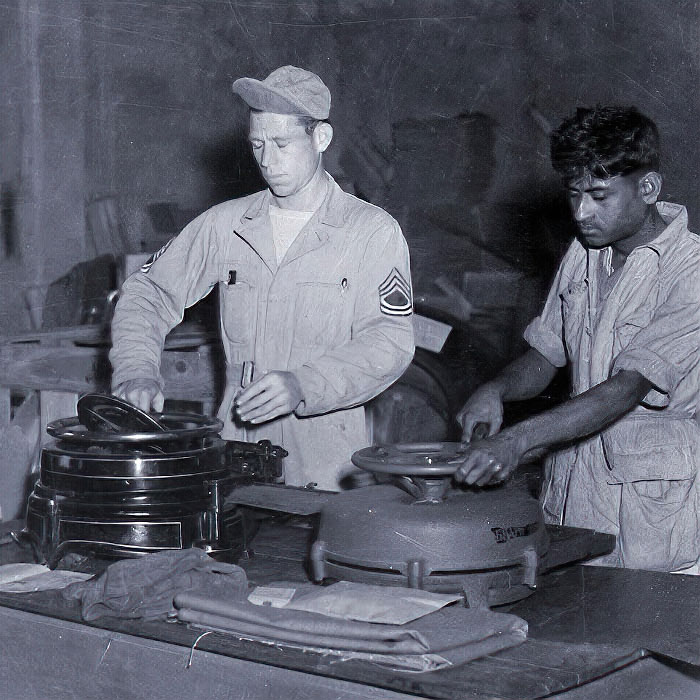Specifications
Specifications for Stencil Machines and Marking
Preface
If you are restoring an old military vehicle and using as many original parts as possible, you will also be using a marking typeface or font for your vehicle that corresponds to the guidelines and tools of the time.
Typically there is a concrete model, like a photo of grandfather in a military jeep.
The jeep, which was one of the most produced vehicles of the Second World War, usually had inscriptions that allowed it to be assigned to a specific unit.
These lettering ranges from very precise, typical stencil typeface, to self-made stencils, to freehand painted lettering.
Even the stencils of the region, for example the typical French stencils, were sometimes used by the Allied troops entering Europe through France.
This probably happened when certain troop units were merged into new units and the required marking equipment was not available in the field.
As for everything that is somehow related to the procurement of the government, these things were officially recorded and numbered, and specifications were created for this purpose.
From erasers to first-aid kits, everything big and small that is ever important in the performance of an activity is assigned to a number.
The U.S. government created a comprehensive national catalog of goods — the National Stock Number (or later NATO Stock Number) system, in short NSN.
There is also an extensive catalog of specifications.
To this day, they form the basis of the US military's acquisition system and are used in part by NATO allies.
These specifications also include the labeling of equipment and the necessary tools.
Former military persons and friends of authentic military history also use it.
Because some of these numbers are commonly used in connection with marking and stenciling machines, they are listed here.

Sergeant Martin L. Mitchell by Texarkana, Texas teaches Indian assistant how to run stencil machines. - US Air Force, 1944
Sergeant Mitchell is on a Ideal stencil cutting machine and the assistant is on machine by Diagraph-Bradley.
We can't see the size of the stencil type on these machines, but the Ideal model is a 1 inch machine.
This can be easily seen by the typical openings in the dial that are only seen on the 1" Ideal.
The US Air Force used many stencil machines for short service instructions and parts specifications on aircraft.
Most were in ½ and ¾ inch in type sizes.
source: https://catalog.archives.gov/id/204964322
Specifiaktion Numbers
U.S. Military Specification for Stencil Cutting Machines
Nov. 07. 1933, GG-M-91 Stencil Cutting-Machines
Feb. 12. 1958, GG-S-747a Stencil Cutting-Machines, hand-operated
Feb. 10. 1964, GG-S-747C Stencil Cutting-Machines, hand-operated
Okt. 31. 1963, GG-S-749D Stencil Cutting-Machines, electric
Jan. 12. 1989, GG-S-747D Stencil Cutting-Machines, hand-operated
U. S. Army Specification for Marking Shipment
No. 100-2C May 27, 1930
No. 100-2D February 4, 1933
Amendment No.1, July 6, 1936
U. S. Military Specification for Marking Freight
94-40645, 94-40645-A Marking; Exterior, Domestic and Export Shipment by Contractors.
MIL-STD-129B, MIL-STD-130
U. S. Army Specification for Marking Equipment
Aug. 05. 1942, AR 850-5, Marking of Clothing, Equipment, Vehicles, and Property
A PDF version of the AR 850-5 specs can be downloaded at jeepdraw.com.
other U.S. Specification related to marking
UU-P-543c, Stencil Board, oiled and unoiled
TT-I-558b, Stencil Ink for non-porous surfaces
TT-I-559b, Stencil Ink for porous surfaces
GG-M-117, Felt Tip Markers
TT-I-544, Felt Tip Markers Ink
H-B-621f, Stencil Brushes
One of the most common numbers or codes is GG-S-747C, which is often written on the case of stencil machines.
This is a specification for manually operated stencil machines.
The manufacturers have advertised the machines to be in compliance with these specifications.
NSN Numbers
These number can be verified at www.nsnlookup.com.
Please note that these numbers can become obsolete.
The typefaces of manual stencils kits has changed since the 2nd World War.
The typeface has become much narrower, usually from a wide Gothic to a narrow Gothic (Sans Serif).
In WWII also Roman stencil typefaces are used.
Please keep this in mind when looking for the right marking tools for your props and restorations.
Samples of NSN Numbers
NSN 7520-00-272-9684, Marking Stencil Set, 5 inch, brass interlocking stencils
NSN 7520-00-269-9012, Marking Stencil Set, 4 inch, brass interlocking stencils
NSN 7520-00-272-9683, Marking Stencil Set, 3 inch, brass interlocking stencils
NSN 7520‒00‒298‒7044, Marking Stencil Set, 2 inch, brass interlocking stencils, (A-A-130A)
NSN 7520-00-272-9680, Marking Stencil Set, 1 ½ inch, brass interlocking stencils
NSN 7520-00-298-7043, Marking Stencil Set, 1 inch, brass interlocking stencils
NSN 7520-00-205-1760, Marking Stencil Set, ½ inch, brass interlocking stencils
NSN 7490-01-102-0752, IDEAL 5/8 INCH machine, hand operated stencil cutting machine,
Note: Marsh's best-selling stencil machine during World War II was the Model S, introduced in 1940, which cut 3/4 stencils.
Ideal's machine, the 5/8" Ideal No. 2, may also be one of WWII's bestsellers.
This should also be conceivable for the 3/4 inch model from Diagraph-Bradley.
All of these machines have a slightly different typeface, which can be found in different size models from the same manufacturer.
But very few people will be able to see that.
See our collection of authentic vintage stencil fonts for more information.
All trademarks mentioned belong to their respective owners.
